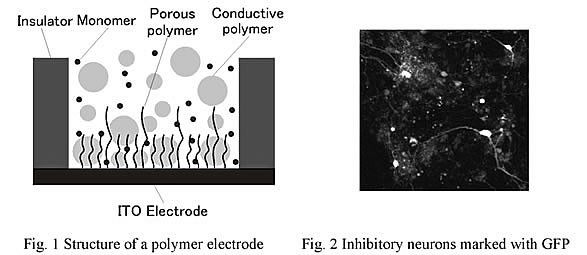and measurements of neural activity with a microelectrode array
Akiyoshi Shimada, Tobias Nyberg, Nahoko Kasai and Keiichi Torimitsu
Materials Science Laboratory
The brain processes information related to perception,
consciousness and behavior by using two types of electrical signals: localized
graded potentials and action potentials. However, it is less well understood
how information is coded by these electrical signals or how neural networks
develop.
To answer these questions, we recorded the activity from dissociated cultures
of rat or mouse cerebral cortical neurons with a microelectrode array (MEA).
MEA-based recording is an effective way to study the relationship between
the electrical activities of individual neurons and the neural network that
they compose.
However, the extracellular signals produced by neurons are generally small.
This has led to the need for a conducting polymer electrode with a low signal-to-noise
ratio. Figure 1 shows the structure of a conducting polymer electrode with
low impedance. The impedance of this electrode was about 5 kΩ at 1 kHz [1],
which is one-twentieth that of a conventional platinized electrode [2]. We
confirmed that this polymer electrode could measure the action potentials
of cortical neurons for more than 1 month.
In addition, there are two types of neurons (excitatory and inhibitory) in
a neural network, and it is difficult to identify the neuron type in living
tissue. So we have employed a recently developed glutamic acid decarboxylase-green
fluorescence protein (GAD67-GFP) knock-in mouse to allow us to observe the
distribution of GABAergic neurons, which constitute the majority of inhibitory
neurons, as shown in Fig. 2. Developmental changes in the spontaneous activity
suggested that GABAergic neurons became active earlier than non-GABAergic
neurons.
We are now investigating the interaction between excitatory and inhibitory
neurons in relation to information processing with this polymer electrode.
[1] T. Nyberg et al., Neuro2004 Sept 21-23, Osaka, Japan (2004).
[2] Y. Jimbo et al., IEEE Trans. Biomed. Eng., 50, 2 (2003)
241.
